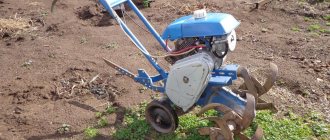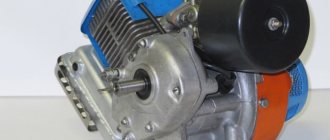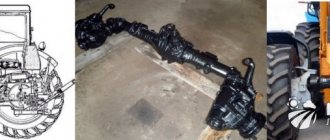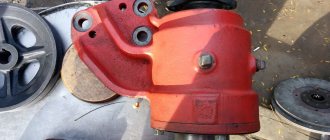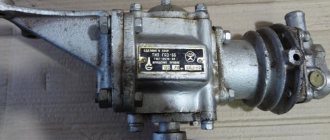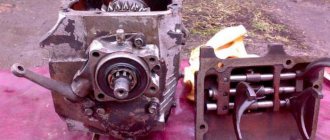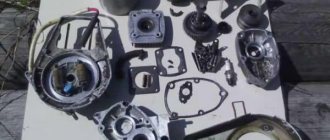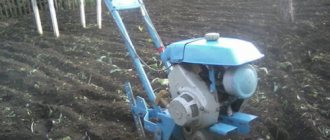Device
The designers of the device made it very ordinary. This, firstly, made it the least vulnerable during operation, and secondly, it allowed people who were far from understanding complex devices to use it for their own agricultural needs.
The dimensions of the “Mole” are approximately 1300x810x1060 mm, which simplifies its storage. Even a shed or garage will do. This makes the service walk-behind tractor even more ordinary and attractive.
The device is simple and consists of a gasoline engine, frame, gearbox, bracket and handle. Removable wheels, which are included in the set, will allow you to not make special efforts during transportation.
The mechanisms with which you can control engine speed, clutch and, in some models, reverse gear are located on the handle. Attachments, such as weeding cutters or wheels needed when working with a plow, are provided for mounting on the gearbox .
The cutters, sharp in themselves, are made of hardened steel, which makes them resistant to external aggressive influences and allows them to be in working order for decades.
Depending on the modification, the units are equipped with motors whose power reaches 6.5 liters. With. This makes the Mole walk-behind tractor a real assistant. The instruction manual is written in accessible language and does not omit any details.
Cultivator Mole motor reducer
For more information about the Mole walk-behind tractor, see
Motoblock dde v700ii-h160w bucephalus-2mn
| "TD Sila" Belomorsk | st. Sovetskaya, 20, tel. Opening hours: Mon-Fri 9-19, Sat-Sun 10-18 | Delivery from 1 day |
| "TD Sila" Kondopoga | w. Oktyabrskoye, 97, tel. Opening hours: Mon-Fri 9-19, Sat-Sun 10-18 | Delivery from 1 day |
| "TD Sila" Kostomuksha | st. Sovetskaya, 18, tel. Opening hours: Mon-Fri 9-19, Sat-Sun 10-18 | Delivery from 1 day |
| "TD Sila" Medvezhyegorsk | st. K. Liebknechta, 23a, tel. Opening hours: Mon-Fri 9-19, Sat-Sun 10-18 | Delivery from 1 day |
| "TD Sila" Olonets | st. Svobody, 8a, tel. Opening hours: Mon-Fri 9-19, Sat-Sun 10-17 | Delivery from 1 day |
| "TD Sila" Pitkyaranta | st. Privokzalnaya, 1, tel. Opening hours: Mon-Fri 9-19, Sat-Sun 10-18 | Delivery from 1 day |
| "TD Sila" Pudozh | st. Pionerskaya, 49a, tel. Opening hours: Mon-Fri 9-19, Sat-Sun 10-18 | Delivery from 1 day |
| "TD Sila" Petrozavodsk | Zavodskaya, 5, building 2, tel. Opening hours: Mon-Fri 9-19, Sat-Sun 10-18 | In stock |
| "Power "Motocenter"" Petrozavodsk | st. Zaitseva 65, building 4, tel. Working hours: Mon-Fri 9:00-19:00 Sat 10:00-18:00 Sun closed | Delivery from 1 day |
| "TD Sila" Sortavala | st. Karelskaya, 16, tel. Opening hours: Mon-Fri 9-19, Sat-Sun 10-18 | Delivery from 1 day |
| "TD Sila" Segezha | st. Solunina, 4a, tel. Opening hours: Mon-Fri 9-19, Sat 10-18, Sun closed | Delivery from 1 day |
| "TD Sila" Suoyarvi | st. Lenina, 38D, tel. Opening hours: Mon-Fri 9:00 – 19:00, Sat-Sun 10:00 – 18:00 | Delivery from 1 day |
| "TD Sila Lenta" Petrozavodsk | st. Leningradskaya, 13, tel. Opening hours: Mon-Fri 9-19, Sat-Sun 10-18 | Delivery from 1 day |
| "Captain" Petrozavodsk | Zaitseva 63, tel. Opening hours: Mon-Fri 9:00-19:00 Sat 10:00-19:00 | Delivery from 1 day |
| "TD Sila" Petrozavodsk | Lesnoy Ave., 53A, tel. Opening hours: Mon-Fri 9:00-19:00 Sat-Sun 10:00-18:00 | Delivery from 1 day |
The belt is an important detail
The V-belt for the motoblock Mole, Caiman, Patriot, Texas, Foreman, Crosser, VIKING, Forza is one of the most necessary elements for the functioning of the unit. Its purpose is to transmit torque from the engine to the components. If you don’t know which belt is on the “Mole” walk-behind tractor, you have the classic A 750 version.
The size of the belt for the “Mole” walk-behind tractor in this case is easily determined - the marking corresponds to it in millimeters. Typically, Soviet and modern Russian designs use just such a detail. On the other hand, you need to check your Mole walk-behind tractor. Drive belt, its size can be 785 mm. Width – 12 mm.
The belt for the Mole walk-behind tractor is used only in this temperature range: 30°C to 60°C.
Just like the oil level, the condition of the V-belt must be constantly monitored. A crack, deformation, change in size - this important part must be changed immediately, since unstable operation of the belt will lead to breakdown or deterioration of the entire device. Replacing it is quite simple.
Reverse speed at home
Reverse speed on the “Mole” walk-behind tractor is not present in all models. Sometimes it even depends on where the unit was produced - or Omsk. Fortunately, craftsmen have come up with a simple way to improve the Mole walk-behind tractor. Modernizations come in different forms.
Fans of DIY improvements may be interested in a homemade grain crusher.
Here is one of the recipes for how to make reverse gear on a “ Mole ” walk-behind tractor. The nut that holds the pulley of the agricultural machine is unscrewed. We string a pulley next to it from, for example, a Volga. We tighten the nut.
In the design of the pressure roller we use a timing belt from any foreign car. And, in fact, the switch in the front of the walk-behind tractor is a small metal bar connected to the entire pressure roller mechanism. The bar is attached to two springs and a cable runs from it to the switch handle on the handle.
Milling cutters
Knives, as they are commonly called, cutters, are installed on the gearbox shaft. The cutters for the Mole walk-behind tractor rotate, while removing the top layer of soil, mixing and crushing it. Plus, thanks to these rotational movements, the device moves forward.
The standard configuration includes four cutters, but their number can be increased to six. How deeply the soil is loosened depends on the position of the attached coulter.
Repair instructions
Repairing the “Mole” walk-behind tractor is simple and quite possible at home. Just take some time to read the instructions and understand the circuit diagram of the device. Then you can repair walk-behind tractor with your own hands without much difficulty.
There are things that will help you repair the “Mole” walk-behind tractor with your own hands. Video is one of them. Craftsmen will clearly show how and in what sequence to repair equipment. Although the equipment is reliable, even it, due to its use in conditions of prolonged multifunctional work, can break down.
But it is also important to understand what caused the Mole walk-behind tractor. Repair instructions may not include a video.
- The problem is the ignition. This, unfortunately, happens quite often in this brand of walk-behind tractors. The first thing to do is check the spark plug. To do this, unscrew it and carry out a visual inspection. If the spark plug is completely dry, this indicates that the fuel-air mixture is not entering the cylinder.
- If it is completely wet, you should bleed the engine using a manual starter. This will dry out the cylinder. The spark plug is burnt - wash it with gasoline and clean it with fine sandpaper.
- Malfunctions of the Mole walk-behind tractor may also be due to the fact that the spark plug not only needs to be cleaned, but needs to be replaced. This is the case if there is no spark.
- If there is still no spark with the new spark plug, there is a possibility that there is no contact in the electrical circuit.
- Ignition is also directly dependent on the condition of the gasoline hoses, the insulation of high-voltage wires or their connection. Take a closer look to see if the flywheel plates are touching the magneto's magnetic circuits. This shouldn't happen.
- And, of course, check the air filter for contamination. By the way, even a dirty muffler negatively affects the performance of the unit.
READ Do-it-yourself tow hitch for a walk-behind tractor
Wheels
Wheels for the Mole walk-behind tractor can be completely different, depending on the work that is planned to be carried out. Sometimes they simply rise or are removed altogether. This is what they do when weeding. One way or another, wheels for all occasions are not provided for the walk-behind tractor.
Wheels differ from each other in the material from which they are made, width, diameter, and seat size. For example, when working among rows of crops, narrow tires are needed, while when digging up potatoes, wide tires are needed. And when the gearbox is located above the plants during operation, the diameter of the wheels must be large so as not to damage the crop.
Cultivation is the loosening of soil that has previously been processed, cutting off weeds and other plants harmful to the crop. A do-it-yourself manual cultivator will save you a lot of money.
A very pressing issue is the treatment of trees and other greenery with special chemicals, which will provide protection against parasites. Here is all about the advantages of the Marolex sprayer.
ZIL-130 is a common Soviet-era truck. By clicking on the link you can familiarize yourself with its technical characteristics.
Since the mass of the walk-behind tractor is small, rubber wheels will not always be able to pull it out and turn and slide. In this situation, metal wheels with special lugs are put on.
How to set the ignition on a cultivator
If the starter cable of the Neva cultivator is pulled frequently, over time the engine begins to start late. In this case:
- Place the square on the candle;
- Press the housing against the cylinder head and turn the ignition element away from the holes;
- Turn the crankshaft and tighten the cable several times;
- A spark should appear when tensioning; if there is none, the required gap between the flywheel and magneto should be adjusted.
Adjusting and tuning the magneto is quite simple. Most often, the cause of a malfunction of a walk-behind tractor coil is a spark plug. Therefore, every owner of a motor cultivator should have a set of spare spark plugs in his tool case.
The most popular spark plugs from well-known manufacturers are Bosch and Subaru.
Checking the spark plugs is done like this. In order to check the serviceability of the coil spark plugs of the MB and MB 1 walk-behind tractor, you need to follow the following instructions:
- Turn out the candle. Wipe the electrodes.
- If there is carbon deposits, clean it.
- Set the distance between the electrodes.
- Place a tip with a high-voltage wire on the spark plug.
- Press against the cylinder body. The electrodes should point in one direction under the spark plug.
- Rotate the crankshaft and observe the formation of a spark. If it is not there, then the fault is in the spark plug.
Oil in the gearbox of a mole cultivator
Checking the oil level of the MK Krot motor cultivator
It is necessary to check the oil level in the motor-cultivator gearbox. To do this, unscrew the oil level control screw 2. If the level is below normal, it is necessary to add TAD-17 or MS-20 oil into the motor-cultivator gearbox through the filler hole. The oil level should correspond to the lower point of the reference mark. The required oil volume is 0.5 l.
When changing the oil in the gearbox, it is better to do this after working with the motor cultivator. In this case, the engine will be warmed up and the oil will be thinner. After changing the oil, do not forget to replace plugs 1, 2, 4 and gaskets 3, 5. Make sure that the oil does not leak.
Transportation of the MK Krot motor cultivator
Cultivator Mole Review
To transport the Mole motor-cultivator to the place of work, lower the transport wheels to the lower position and secure them with the help of axles and clamps.
Wheels
Wheels for walk-behind tractor can be completely different, depending on the work that is planned to be carried out. Sometimes they simply rise or are removed altogether. This is what they do when weeding. One way or another, wheels for all occasions are not provided for the walk-behind tractor.
Wheels differ from each other in the material from which they are made, width, diameter, and seat size. For example, when working among rows of crops, narrow tires are needed, while when digging up potatoes, wide tires are needed. And when the gearbox is located above the plants during operation, the diameter of the wheels must be large so as not to damage the crop.
Cultivation is the loosening of soil that has previously been processed, cutting off weeds and other plants harmful to the crop. A do-it-yourself manual cultivator will save you a lot of money.
A very pressing issue is the treatment of trees and other greenery with special chemicals, which will provide protection against parasites. Here is all about the advantages of the Marolex sprayer.
ZIL-130 is a common Soviet-era truck. By clicking on the link you can familiarize yourself with its technical characteristics.
Since the mass of the walk-behind tractor is small, rubber wheels will not always be able to pull it out and turn and slide. In this situation, metal wheels with special lugs are put on.
Making a complex device
If you want to make a device that can be mounted on a mini tractor with your own hands, which can be controlled from 2 sides, you will need:
Two-row hiller device for a mini tractor.
- water pipe for vertical stand;
- hollow pipe with a diameter of ¾ inches for the front and rear links;
- steel sheets 1−2 mm for the manufacture of dumps;
- turnbuckle for connecting the front link and vertical post for stepless adjustment of the angle of attack;
- welding device;
- other tools.
Having found all the necessary parts to assemble a hiller for a walk-behind tractor with your own hands, you can begin assembly and adjustment, which takes place in several stages:
- To adjust the height, you will need a telescopic device. Another tube of smaller diameter is inserted into the central pillar pipe, which is directed backwards. Thanks to this, it will be easier for farmers to adjust the desired height to their height.
- The angle of attack should be calculated so that it is easy to control the inclination in accordance with the plane of the earthen layer. This can be achieved by changing the angle between the main rod and the stand. The rod is attached to the post with a lanyard, which allows you to control and smoothly change the direction of the device.
- The stand itself is made of a pipe measuring 900-1000 mm, which bends by 15°. This kind of bending is best done with a special tool - a pipe bender.
If you don’t have it at hand, fill the pipe with sand as tightly as possible. Use a blowtorch to heat the bend until red and bend it slowly. The sand in the pipes prevents the edges from joining, which helps maintain their shape (caliber).
Figure 2. Types of pointed paws for hillers.
- Making both hiller rods for a walk-behind tractor is very simple. The rear link is a fork, somewhat similar to the letter “P”. Its width reaches 500 mm, and its length - 200 mm. A small piece 300 mm long needs to be welded to this fork and inserted into the vertical rod.
- The front part has the same assembly pattern as the rear. The only difference is that its arms are slightly longer. This is done on purpose so that people can grab them comfortably.
- To make it easier to control, you can attach a shoulder strap, which can greatly reduce the load on your hands. Its vertical part reaches a length of 600−700 mm. It flattens out at the end. On this part, make special holes through which the belt will be attached to the device.
- The process of making a plow begins with cutting out 2 similar plates with a minimum thickness. Give them a bend, as is the case with conventional plows. Weld both parts to the stand.
- And finally, the manufacture of the last element - a pruning knife, which takes on the entire brunt of the work and fights with hard soil. To make such a knife, take strong steel (plate). Cut a triangle out of it, ending in an arrow-shaped figure, and sharpen it at an angle of 40° (Figure 2). This procedure is carried out so that the instrument does not become dull for a long time.
A homemade hiller for a mini-tractor is better than an industrial propeller-driven motor-cultivator in that it does not require large manufacturing costs, and there are a lot of ideas for assembling a hiller for a walk-behind tractor on your own.
For example, you can use old bicycle wheels as a disk. It also doesn’t take very much time to assemble a homemade potato hiller - from 3-4 hours to several days. A hiller made in this way will serve you on your own for many years.
Device
The designers of the device made it as simple as possible. This, firstly, made it less vulnerable during operation, and secondly, it allowed people who were far from understanding the complex mechanisms to use it for their agricultural needs.
The dimensions of the “Mole” are approximately 1300x810x1060 mm, which simplifies its storage. Even a barn or garage will do. This makes servicing the Mole walk-behind tractor even simpler and more attractive.
The device is simple and consists of an internal combustion engine, frame, gearbox, bracket and handle. The removable wheels that are included in the kit will allow you to not make special efforts during transportation.
The mechanisms by which you can control engine speed, clutch and, in some models, reverse gear, are located on the handle. Attachments, such as weeding cutters or wheels, necessary when working with a plow, are provided for mounting on the gearbox .
The cutters, sharp in themselves, are made of hardened steel, which makes them resistant to external aggressive influences and allows them to be in working order for decades.
Depending on the modification, the units are equipped with motors whose power reaches 6.5 liters. With. This makes the “ Mole ” walk-behind tractor a real assistant. The instruction manual is written in accessible language and does not omit any details.
For more information about the Mole walk-behind tractor, see
Motor cultivator Mole. Changing the oil in the drive gearbox
Piston ring
The piston ring of the Mole walk-behind tractor is replaced if the gap at the joint of the rings is more than 1 mm. They are inserted one by one into the cylinder to a depth of eight to ten millimeters.
There is a whole so-called cylinder-piston group for the Mole walk-behind tractor unit. There are two piston rings in it. The material from which the rings and other parts of the group are made, as well as the accuracy of their fit, greatly influences the working life.
- Piston pin 11mm;
- Piston rings 2 pcs. ;
- Cylinder;
- Piston.
To prevent the parts of the cylinder-piston group, and all the others, from drying out, do not let the walk-behind tractor stand idle for more than one season. This has a detrimental effect on the device, which, if used regularly, practically does not kill.
READ How much to dilute oil with gasoline for trimmer
The magneto on the “Mole” walk-behind tractor, namely its coil, becomes inoperative when the equipment is left idle for a long time.
What awaits the owner of a walk-behind tractor after switching to a new type of fuel?
In order to successfully use 92 gasoline instead of 80, after the conversion you will have to adhere to certain rules when operating the equipment. Having studied and observed them, the owner of a walk-behind tractor will not make mistakes typical of most inexperienced farmers. During operation, you must ensure:
- Depending on the condition of the cylinders, carbon deposits formed by gasoline vapors may accumulate on their walls;
- For the serviceability of the transmission - at first it may “fail” when changing gears;
- If strange sounds appear, they indicate a motor malfunction.
After remaking the walk-behind tractor, experts advise not to overload the equipment for the first few months. Short pauses will help avoid unwanted breakdowns.
In fact, 80-grade gasolines were illegal in our country until recently. Back in 2008, with the introduction of the Technical Regulations on fuels, it was popularly explained to us: they are bad, environmentally dirty and are in no way suitable for the foreign cars of officials and deputies. Therefore, they were not even included in environmental class 2, the lowest according to the Regulations.
The entry into force of this tricky document has been repeatedly postponed. Finally, in the fall of 2011, when only class 4 gasoline should have been sold throughout Russia (according to the first edition of the Regulations), it turned out that the majority of refineries had not even reached class 3 (such fuel was allowed to be produced until the end of 2009)! At the same time, further amendments were adopted, which... abolished all restrictions on the octane number. Now it is possible, without looking at the timing, to produce any gasoline, be it 72nd or 110th, as long as all other requirements for the environmental friendliness of the fuel are met.
However, the process has begun: oil workers have been curtailing production of 80-grade gasoline since 2008. Today, although it is “legal”, it is in terrible short supply! And since the largest refineries have stopped producing it altogether, this brand is brought from old factories that did not have time to wake up with the introduction of the Regulations, or from semi-handicraft mini-refineries, where they obtain cheap low-quality surrogates by distilling gas condensate. As a result, refueling with 80 has now become complicated, relatively expensive, and unpredictable in its consequences!
What should we feed the old dinosaurs? There are ZILs and Muscovites here, and old motorcycles, and outboard motors... Won't they feel bad? Let's check.
The belt is an important detail
The V-belt for the motoblock Mole, Caiman, Patriot, Texas, Foreman, Crosser, VIKING, Forza is one of the most necessary elements for the functioning of the unit. Its purpose is to transmit torque from the engine to the components. If you don’t know which belt is on the “ Mole ” walk-behind tractor, you have the classic A 750 version.
The size of the belt for the “Mole” walk-behind tractor in this case is easily determined - the marking corresponds to it in millimeters. Typically, Soviet and modern Russian designs use just such a detail. On the other hand, you need to check your “ Mole ” walk-behind tractor. Drive belt, its size can be 785 mm. Width – 12 mm.
The belt for the Mole is used only in this temperature range: 30°C to 60°C.
Just like the oil level, the condition of the V-belt must be constantly monitored. A crack, deformation, change in size - this important part must be changed immediately, since unstable operation of the belt will lead to breakdown or deterioration of the entire device. Replacing it is quite simple.
Air filter
An important element thanks to which the normal power of the unit is maintained and less fuel is consumed. The air filter for the Mole walk-behind tractor cleans the air masses from all kinds of particles and dust, which are sufficient when working in the field.
The material from which it is made is paper, which is based on cellulose fiber. If the filter is dirty, the air-fuel mixture will not function properly in the carburetor, which will negatively affect the operation of the device. Contamination is assessed visually.
If the filter is still dirty, it must be replaced immediately. Alternatively, it can be disassembled and cleaned, but this is only in case of surface contamination.
Disassembling the filter proceeds as follows:
- The filter housing is removed by unscrewing the nut on it.
- The body is washed with water and wiped dry.
- The filter element can be cleaned with a jet of air.
- If this does not help, the filter is replaced.
Never operate the walk-behind tractor without a filter element.
Oil features
Despite the simplicity of design and use, there are several points, ignorance of which will negatively affect the operation of the unit. For example, what kind of oil to fill.
You will need three types of oil for the Mole walk-behind tractor: separately for the fuel mixture, oil for the engine gearbox and for the output gearbox.
- For the fuel mixture, M-12 should be used in a ratio of 1:20 to gasoline. This is a common type of oil used for two-stroke gasoline engines.
- The oil in the gearbox of the Mole walk-behind tractor should be MG-8A. This is the so-called hydraulic oil .
- For the output gearbox, you should purchase transmission oil TAD-17.
You can choose a manufacturer based on your financial capabilities. There are domestic brands that are cheaper, and imported ones that are correspondingly more expensive.
It is highly recommended not to use pure gasoline as fuel.
You should always check the amount of oil in the engine gearbox. Its level should always be higher than the inspection hole mark. If the levels match, simply add 0.2 liters through the special hole.
It is not worth preparing the fuel mixture directly in the tank of the unit; it is better to use a separate vessel for this purpose. If there is no other way, then first pour in half of the required volume of gasoline, then all the oil , stir for about ten minutes, and only then add the second half of gasoline.
Transition from 80 to 92 gasoline - how to convert a walk-behind tractor yourself?
Many owners of agricultural equipment are trying to change the type of fuel consumed by their units. Converting a walk-behind tractor to another “diet” is not easy, but there is nothing overly complicated in such an event. Let's look at methods for performing this operation yourself.
Converting an engine to run on a different fuel - what are the advantages?
Even novice gardeners and gardeners know that grade 92 gasoline is much higher quality than cheaper fuel analogues. However, is it possible to pour 92 gasoline instead of 80 into a walk-behind tractor? Every expert will confidently answer “no.”
Even if your walk-behind tractor has a reliable design and high quality parts, it still will not work for a long time on fuel that is not standard for it. Cheaper walk-behind tractors do not start at all after changing the brand of gasoline.
Because of this, in order to refuel your equipment with good fuel, you have to slightly alter its design. As a result of the changes, the owner of the walk-behind tractor receives the following benefits:
- Extending the life of important parts and components of the unit;
- No need to change seals and filters every few months;
- Increasing the service life of the motor and gearbox;
- Less fuel consumption.
All these advantages encourage equipment owners to start working without hesitation. There are two ways to convert a walk-behind tractor to use 92 gasoline instead of 80. Below we will consider each of them separately.
Ignition timing adjustment method
This method is best described using the example of the UMZ-341 motor. This universal engine is equipped with almost the same parts as other domestic and imported engines.
Before converting a walk-behind tractor engine from 80 to 92 gasoline, you will need to replace spark plug A 11-3 with spark plug A17B. After this, you can begin to adjust the advance angle to move it no more than 2 degrees counterclockwise. The work algorithm looks like this:
- Completely drain the gasoline from the gas tank of the walk-behind tractor;
- Start the engine and give it time to burn out all remaining fuel;
- Remove the spark plug tip;
- Remove the 4 bolts holding the fan shroud;
- Remove the casing;
- Next, you will need to unlock the flywheel fixing nut;
- Unscrew the nut and remove the ratchet;
- Install the flywheel puller. To do this, tighten the puller screw and lightly hit it with a hammer;
- Find the ignition adjustment mark;
- Use a screwdriver to loosen the magneto. After this, move its base 2 mm to the left.
After completing these procedures, you need to assemble the engine. During assembly, make sure there is a key on the end of the crankshaft. Tighten the flywheel mounting nut to a torque of 16 kgf/m and secure with a lock washer. While doing this, work with the part that is not jammed. After the modification, you can confidently fill the tank of your walk-behind tractor with 92 gasoline - the unit will work like clockwork.
Method for increasing engine compression ratio
This method is a little more complicated than the previous one. All work must be done as accurately as possible so as not to damage the motor of the walk-behind tractor. The essence of the method is based on removing a layer of metal no more than 2.5 mm thick from the plane of the cylinder head. Thanks to this kind of grinding, the engine compression rate increases to 7.8 atm. In addition, you will also have to replace the spark plugs - new datleys must have a heat number of at least 16 units.
As an alternative to this method, you can replace the cylinder heads with elements of grade 421. 1003010. However, in addition to replacing the head, you will need to replace the valve rods of the pushers. For this purpose, you can buy a special set of push rods and adjusting screws
It is important to remember that the kit, like a new cylinder head, will not be cheap. Therefore, it is best to spend a little of your time and adjust the ignition timing
What awaits the owner of a walk-behind tractor after switching to a new type of fuel?
In order to successfully use 92 gasoline instead of 80, after the conversion you will have to adhere to certain rules when operating the equipment. Having studied and observed them, the owner of a walk-behind tractor will not make mistakes typical of most inexperienced farmers. During operation, you must ensure:
- Depending on the condition of the cylinders, carbon deposits formed by gasoline vapors may accumulate on their walls;
- For the serviceability of the transmission - at first it may “fail” when changing gears;
- If strange sounds appear, they indicate a motor malfunction.
After remaking the walk-behind tractor, experts advise not to overload the equipment for the first few months. Short pauses will help avoid unwanted breakdowns.
Description of the design of the Mole walk-behind tractor
The frame, consisting of two half-frames, is bolted to the gearbox. Tubular cultivator control handles and a bracket for installing additional attachments are located at the rear of the walk-behind tractor. The handles contain controls for engine speed and clutch (on the Krot-2 modification, reverse gear is also engaged).
The output shafts of the Krot gearbox are equipped with soil cutters with a diameter of 320 mm for plowing the soil, weeding or wheels (for working with a hiller (or plow, as well as for operating a cultivator with a trolley). An internal combustion engine is attached to the frame, connected by a V-belt transmission to the input shaft of the gearbox.
The fuel tank is located on top. Lifting wheels are used to roll the cultivator, but during operation they must be raised or removed.
Drive belt (for attachments)
- The belt slips;
- The belt comes off the pulley.
- The use of a non-standard, long-length belt;
- The belt has increased in length (stretched);
- The belt is not tensioned;
- The belt is on the wrong pulley.
- Tension the belt using a tension roller;
- Replace the stretched belt;
- Check that the belt is positioned correctly relative to the engine pulleys and attachments or trailed equipment.
Latest
- Rimma Abdrakhmanova December 1, 17:40 Well done! DIY hemisphere shelf
- kam-tour Pasyukov December 1, 14:06 And the fastening to the wall is also done with glue? DIY hemisphere shelf
- Lyudmila Dmitrieva December 1, 13:38 Is the article about this fact? How to “save” furniture during renovation
Do-it-yourself electric cultivator
For weeding between rows and working in the garden, I made a small electric cultivator. With its help, victory over weeds is guaranteed. Compared to more capricious gasoline or diesel engines, it is reliable and successful, turn it on and go.
As a drive I used an ordinary grinder, without any modifications.
The only thing you have to do before agricultural work is to temporarily unscrew the side handle. What remains for our client to do is three holes for attaching the side handle, which I use to attach this improvised drive to the cultivator. Working with a cultivator is seasonal, so for the most part I use the grinder for its intended purpose.
Owner reviews of motoblocks “Krot” and “Krot-2”
In fairness, it should be noted that the majority of positive recommendations about “Moles” and about working with them. The truth, as always, is somewhere in the middle between two opposing points of view.
In general, the equipment is reliable and hardworking. It loosens the soil efficiently - better than with a plow and faster than with a shovel. At the same time, it crushes weeds and their roots.
For virgin and complex (in particular, clayey) soils, the MK-1 Mole is of little use: the motor power is clearly insufficient, it overheats; the quality of processing leaves much to be desired; you have to go through the same area two or three times. But the more powerful Krot-2 can already show quite satisfactory performance on such lands.
The weak point of the “Mole” is the piston group; after several years of operation, almost every “Mole driver” has to change the piston with rings. Over time, the starter fails, but it is usually not restored, using a matuska rope wound around the starter shaft to start the engine.
The frame and handles are not very strong, according to many owners, and they have to be strengthened by welding additional parts. And the main gearbox , cutters, belt drive, clutch are reliable and durable, they work properly. The reliability of operation and service life of the Mole walk-behind tractor will increase significantly if you strictly follow the instructions for its operation and maintenance set out in the instructions.
READ Oil for pneumatic tools, what to replace
For example: do not use the walk-behind tractor at full capacity for the first 15 hours of its operation - the period of running-in of all parts. A typical mistake is this: the newly-minted owner of a motorized cultivator, “to celebrate,” immediately sets the technique at a rapid pace on difficult soils. As a result, the capabilities of the already weak motor are further reduced in the future.
The owners also note that during operation, the space between the rotary knives and the gearbox housing can often become clogged with earth, stones, roots, wire and other foreign objects. You must immediately turn off the engine of the walk-behind tractor and carefully remove stuck objects. If the soil is hard or there are a lot of small stones (roots) in it, then it is necessary to reduce the rotation speed of the rotary knives.
When transporting a walk-behind tractor in the trunk of a car, in order to prevent oil from spilling out of the gearboxes, lay the walk-behind tractor on its side, with the starter facing up, while the fitting (tube with a rubber plug) for pouring oil into the working shaft gearbox should be raised relative to the bottom of the gearbox. The use of high-quality motor oil for mixing with gasoline is also of great importance.
How to convert a walk-behind tractor engine from 80 to 92 gasoline?
There are 2 proven ways to complete this procedure. You can convert a walk-behind tractor not only from 80 gasoline, but also from AI-76 to AI-92. We will describe each method in detail below.
Method 1: Adjusting the ignition timing
This conversion method is easiest to demonstrate using the UMZ 341 motor as an example, since it is the most universal and is equipped with the same spare parts as most motors for walk-behind tractors.
Before starting the alteration, you should replace the A11-3 spark plug with an A17B one. After this, adjust the lead angle in the following sequence:
- Completely drain the old fuel from the gas tank.
- Start the engine (so that the remaining gasoline in the fuel system is completely used up).
- Remove the candle tip.
- Unscrew the bolts that secure the fan casing and remove it.
- Unscrew the flywheel fixing locknut and remove the ratchet.
- Install the flywheel puller. To do this, tighten the central bolt of the puller and, after hitting it lightly with a hammer, remove the flywheel. When removing the flywheel, do not hit it.
- Find the factory ignition installation mark.
- Use a screwdriver to loosen the magneto mount and turn its base counterclockwise by 2 mm.
Once all steps are complete, assemble the motor. Make sure all parts are present and in the correct position, and tighten all bolts and nuts. Now you can safely refuel your walk-behind tractor with 92 gasoline, enjoy its work and evaluate the results after the modification.
Method 2: Increasing the engine compression ratio
The method is a little more complicated than the previous one, it requires increased concentration and high precision of execution so as not to damage the equipment. This method involves grinding the cylinder head, as a result of which it is necessary to remove a layer of metal no more than 2.5 mm thick. After this, engine compression will be increased to 7.8 atmospheres. You should also replace the spark plugs with new ones with a heat rating of at least 17 units.
There is a safer and more accurate way to carry out this modification. Purchase a ready-made set of a new cylinder head, valve rods and pushrods and install them. But such a replacement will cost money.
The methods described above for converting walk-behind tractors are suitable for many models of walk-behind tractors, including models such as Neva MB1 and MB2, MTZ-05 and MTZ-12, modifications of walk-behind tractors of the Agro and Cascade brands.
Device
The designers of the device made it as simple as possible. This, firstly, made it less vulnerable during operation, and secondly, it allowed people who were far from understanding the complex mechanisms to use it for their agricultural needs.
The dimensions of the “Mole” are approximately 1300x810x1060 mm, which simplifies its storage. Even a barn or garage will do. This makes servicing the Mole walk-behind tractor even simpler and more attractive.
The device is simple and consists of an internal combustion engine, frame, gearbox, bracket and handle. The removable wheels that are included in the kit will allow you to not make special efforts during transportation.
The mechanisms by which you can control engine speed, clutch and, in some models, reverse gear, are located on the handle. Attachments, such as weeding cutters or wheels, necessary when working with a plow, are provided for mounting on the gearbox.
The cutters, sharp in themselves, are made of hardened steel, which makes them resistant to external aggressive influences and allows them to be in working order for decades.
Depending on the modification, the units are equipped with motors whose power reaches 6.5 liters. With. This makes the Mole walk-behind tractor a real assistant. The instruction manual is written in accessible language and does not omit any details.
For more information about the Mole walk-behind tractor, see
Question answer
What functions can the Krot walk-behind tractor perform?
In addition to the basic function of digging up soil, “Mole” will be extremely useful when planting vegetable crops, hilling, and harvesting. In addition, the “Mole” can replace a mower and also does an excellent job of clearing the area from leaves and snow.
Are there any disadvantages to the MK-1 A model?
This model has many advantages, but among the disadvantages we can only note the lack of reverse, which limits the movement of the walk-behind tractor along one path forward.
Which Krot models have reverse?
If reverse is one of the selection criteria, you should pay attention to MK 3-A-3. “Mole” comes complete with domestic engines only, or do some models use foreign-made engines?
“Mole” comes complete with domestic engines only, or do some models use foreign-made engines?
There are models that use fairly powerful foreign-made power units, for example, MK 9-012, equipped with an excellent Hammerman engine.
Does soil composition affect the choice of cultivator or does it not really matter?
Yes, this is one of the main criteria for choosing a walk-behind tractor. In cases where clay predominates in the soil or there is a high level of turf or cover crops, it is better to give preference to a disc walk-behind tractor. If the clay level is low, then purchasing a cultivator with teeth would be a rational choice.
Scope of application and possibilities of use
The specific purpose of the “Mole” motor-cultivator is to perform a wide Spectra of agricultural work on soil cultivation. In summer cottages and household plots, in vegetable gardens and farmsteads. The owners of these small “lands” know from experience that digging them up by hand only requires a significant investment of time and physical effort. And the Mole walk-behind tractor is designed to save time, energy and health of its owner.
The main tillage operations are carried out using the working part of a motor cultivator - a milling cutter (rotors with specially shaped knives). Torque from the engine through a V-belt drive, gears and sprockets with a chain is transmitted to the gearbox shaft with rotors mounted on it. When rotating, the rotor knives cut off layers of soil, crumble and mix them, while simultaneously causing the forward movement of the motorized cultivator.
Compared to a plow, a milling machine better loosens the soil, crushes the roots of weeds, and evenly mixes organic and mineral fertilizers with the soil throughout the entire depth of cultivation. Manufacturers assure that the use of the Mole motor-cultivator is possible even on heavy soils and when cultivating virgin lands.
Additional attachments significantly expand the scope of application of the Mole walk-behind tractor. In particular, it can be used to carry out inter-row weeding; hilling potatoes; mowing the grass.
The Mole walk-behind tractor can also be used for pumping water from open reservoirs and containers. To do this, a pumping unit is installed on its frame, connected by a V-belt drive to the engine. And the V-belt drive is removed from the traction gearbox. The MNU-2 pumping unit used for this work, of course, must be purchased separately.
The “Mole” can also be of some use for transporting cargo weighing up to 200 kg on a small-sized trolley “TM-200” with a rotary coupling device. Rubber-coated wheels are put on the output shafts of the gearbox. “Mole” is relatively easy to handle, does not require a large storage space, and its low weight and dimensions make it easy to transport.
Video review
To see the motor cultivator in operation, and also to evaluate its capabilities before purchasing the unit, we suggest watching the video review.
Every owner of a summer cottage, one way or another, has a need to care for a vegetable garden, flower beds, or simply plow the soil for sowing lawn grass. Equipment such as the Mole cultivator copes with this task perfectly.
The unit is used for various types of soil treatment: loosening, digging to add fertilizer, weeding, hilling, pumping water. The equipment can be used not only for its intended purpose - in the summer, spring and autumn, the device will serve as an excellent transporter.
The belt is an important detail
The V-belt for the motoblock Mole, Caiman, Patriot, Texas, Foreman, Crosser, VIKING, Forza is one of the most necessary elements for the functioning of the unit. Its purpose is to transmit torque from the engine to the components. If you don’t know which belt is on the “Mole” walk-behind tractor, you have the classic A 750 version.
The size of the belt for the “Mole” walk-behind tractor in this case is easily determined - the marking corresponds to it in millimeters. Typically, Soviet and modern Russian designs use just such a detail. On the other hand, you need to check your Mole walk-behind tractor. Drive belt, its size can be 785 mm. Width – 12 mm.
The belt for the Mole walk-behind tractor is used only in this temperature range: 30°C to 60°C.
Just like the oil level, the condition of the V-belt must be constantly monitored. A crack, deformation, change in size - this important part must be changed immediately, since unstable operation of the belt will lead to breakdown or deterioration of the entire device. Replacing it is quite simple.
Sources:
https://dachnyj-mir.ru/ogorod/maslo-v-reduktor-motokultivatora-krot.html https://mtz-80.ru/bez-rubriki/motokultivator-krot-razmery-harakteristiki-instrukciya-po-ekspluatacii
